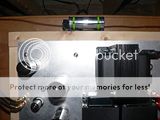I've got a GE branded "DIELEKTROL" capacitor, salvaged from a dead microwave oven. It says it is 1.6 uF, rated for 1250 VAC. Is this thing safe to stick into my Simple SE? I don't know if it is rated for continuous duty or not (motor run vs. motor start). I'd imagine a microwave oven could be left running for an hour or more (cooking the Thanksgiving turkey? eww.) so in all likelihood it would be safe. The voltage rating is certainly high enough. Is 1.6 uF enough capacitance to hear any benefit in the Simple SE power supply? I've got to imagine this thing has a ridiculously low ESR. Physically, it is a rather good size (3.5" tall by 2.25" x 1.25" oval).
Any thoughts? Shall I just plug it in and see what happens?
Any thoughts? Shall I just plug it in and see what happens?
Just an FYI, motor run caps from Dayton have been popping up on sale here and there; Grainger has several on closeout for under $10 (whether you can get one depends on your local store's stock on hand), and there are several online merchants that have them with decent capacity (60+ mfd) for roughly the same price at low or no shipping.
Well, I sorta forgot my 9"x14" chassis was kinda snug for the Simple SE and all its iron. I've got virtually no free space underneath. In a brilliant flash of stupidity, I decided to hang the cap on the outside of the chassis.


http://i69.photobucket.com/albums/i43/Ty_Bower/Simple SE/P1140551.jpg
http://i69.photobucket.com/albums/i43/Ty_Bower/Simple SE/P1140548.jpg
I'm not too sure I'm happy with the thought of 450 VDC on the exposed contacts. 😱


http://i69.photobucket.com/albums/i43/Ty_Bower/Simple SE/P1140551.jpg
http://i69.photobucket.com/albums/i43/Ty_Bower/Simple SE/P1140548.jpg
I'm not too sure I'm happy with the thought of 450 VDC on the exposed contacts. 😱
I'm not too sure I'm happy with the thought of 450 VDC on the exposed contacts.
I'll install a non-inductive cover and ground the cap's housing if I were you. Uncover HV always made me uncomfortable.
Sidney
I like the day-glo zip ties.
How does it sound? Are you running it as a bypass on C1 or on C2?
David
How does it sound? Are you running it as a bypass on C1 or on C2?
David
How does it sound? Are you running it as a bypass on C1 or on C2?
Assuming I've wired it correctly, it is in parallel with C2. It's tough for me to evaluate any difference in sound. I've recently made a bunch of other changes in the system. I think I need to listen to it for a few days, then try unplugging it and see if it is missed.
It has small enough capacitance that you could probably put it instead across C1 and keep a more conventional motor run cap on C2. Assuming of course you have room on the chassis.Assuming I've wired it correctly, it is in parallel with C2.
Can someone clarify the use of the auxiliary cap? I have a huge honking 50 uF motor-run cap installed, and I don't think it made much difference.
Is this primarily to filter the power supply? Would installing a larger value C2 achieve similar results? IIRC, since this is a Class A amp, there shouldn't be a lot of power supply sagging during operation....
Is this primarily to filter the power supply? Would installing a larger value C2 achieve similar results? IIRC, since this is a Class A amp, there shouldn't be a lot of power supply sagging during operation....
Can someone clarify the use of the auxiliary cap?
For single ended amplifiers, the last capacitor in the power supply chain becomes part of the audio signal path. Whatever AC signal fluctuates through the output transformer and the power tube must also travel through that capacitor. You want a fair amount of capacitance there to minimize hum, but you also want the "best" audio characteristics possible too. This probably means a low AC impedance, but surely includes other attributes as well (minimal hysteresis? high frequency response?). I'm not an electrical engineer, nor have I studied signal theory. AC is still a lot of black art to me, and I never did care for vectors. I don't fully understand it, but I know there is some science there.
Regardless, the concept is that an aluminum electrolytic will buy you a lot of hum reducing capacitance for not too much money, and an additional oil filled foil type cap will offer the desirable audio characteristics. I say give it a try and see if you can hear a difference. Motor run caps sell for less than $20 shipped.
So let me ask this a little differently...
I think what we're dealing with is power supply filtering and ripple reduction.
I found a 50 uF motor-run cap that I installed (yep, $20, oil filled, HUGE). It seems that the Aux Cap is in parallel with C2 (I used a 120 uF or so) giving me a total of 170 uF.
Wouldn't I get the same ripple filtering by installing a larger value C2 ? This would reduce the need for the external motor run cap? Maybe larger values aren't feasible before needing to go to the motor run cap sizes...
I think what we're dealing with is power supply filtering and ripple reduction.
I found a 50 uF motor-run cap that I installed (yep, $20, oil filled, HUGE). It seems that the Aux Cap is in parallel with C2 (I used a 120 uF or so) giving me a total of 170 uF.
Wouldn't I get the same ripple filtering by installing a larger value C2 ? This would reduce the need for the external motor run cap? Maybe larger values aren't feasible before needing to go to the motor run cap sizes...
As Ty stated the key here is that there is some synergism between the two different types of capacitors. The on board electrolytic packs a lot of capacitance in a small package. It like all capacitors is not perfect. Electrolytics have flaws that make it hard to get all of the energy out of the cap quickly and they aren't too good of a bypass at the upper end of the audio spectrum. The polypropelyne motor run cap can dump its energy quickly enough to blow the end off of a small screwdriver (really improves the transients) and it works great across the entire audio range, but one large enough to provide all of the capacitance to run the entire amp would be quite large. Together thay work quite well.
- Status
- Not open for further replies.
- Home
- More Vendors...
- Tubelab
- Simple SE, auxiliary cap?